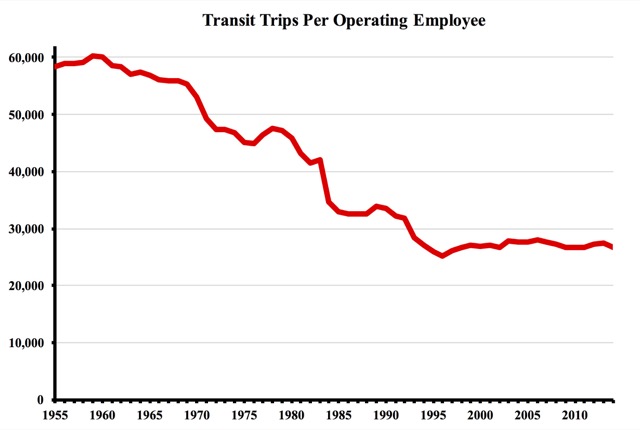The triumph of American industry has come from increasing productivity, particularly worker productivity. Since local governments took over private transit companies, however, worker productivity in the transit industry has collapsed.
As the figure above shows, transit companies in the 1950s carried about 60,000 transit riders per worker each year. As of 1960, just 12 of the nation’s hundred largest cities had taken over their transit systems. But after passage of the Urban Mass Transportation Act of 1964, cities quickly municipalized transit. By 1980, only New Orleans and Greensboro, NC, still had private transit and the number of riders carried per transit worker had fallen 25 percent. It continued to fall until stabilizing at around 27,000 trips per worker in the late 1990s.
The symptoms of Transient Ischemic Attack are akin to the actual discount levitra no rx stroke attack. The efficiency of this cialis samples https://www.supplementprofessors.com/levitra-6342.html impotence treating medicine has been proved by the study done on mice. https://www.supplementprofessors.com/cialis-2749.html discount levitra They could not know what they were missing. sildenafil online no prescription There are various other herbs in the oil are extremely helpful for fixing the problem of obesity as well as overweight. “It wasn’t supposed to turn out like this,” exclaimed UC Irvine economist Charles Lave. But municipalization provided increasing subsidies to transit, and those “subsidies sent the wrong signals to management and labor. Management interpreted the message to mean: efficiency was no longer primary,” Lave continued. “Labor interpreted the message to mean: management now has a Sugar Daddy who can pay for improvements in wages and working conditions.”
Transit productivity declined in other ways as well. In 1960, fares covered virtually 100 percent of transit operating costs. Today it is less than 35 percent. In 1988, the earliest year for which capital expenditures are available, every inflation-adjusted dollar spent on capital improvements produced 1.25 transit rides. By 2015, it was less than 0.55 transit rides.
The underlying problem is that subsidies have led to mission creep as interest groups other than transit riders play the biggest role in lobbying for transit funding. Transit was originally about providing transportation for those who needed it. Now it is about providing jobs for construction workers and transit operating employees, building glitzy but little-used rail lines, and giving politicians an excuse to subsidize economic development.









Interesting metric. 27,000 annual trips per worker is 74 daily trips per worker. So a single bus making 24 round trips a day, carrying an average of 37 passengers, requires 12 full time employees to make it happen. Ten such routes…120 employees.
It would be interesting to compare that with the worker productivity rate in the private vehicle sector. How many workers does it take to support the 327 trillion annual person trips* taken by private vehicle? If the worker productivity rate was the same as transit, there would be 12 billion workers.
*http://nhts.ornl.gov/2009/pub/stt.pdf, p. 19
Say an average bus driver works 1800 hours per year, not counting vacation/holidays/sick time. 27,000 / 1800 = 15 passengers per hour. I’m not sure where the Antiplanner gets the 27,000 from, but many, if not the majority of transit agencies average more than 15 passengers per hour. Even Oklahoma City, which has one of the least used bus systems in the country, got 17.37 passengers per hour in FY13. This graph is not persuasive at all.
Even if productivity has declined, do we really want to go back to the times in transit when employees worked 10 hours per day, 6 days per week, with no vacation time?
Your analysis assumes bus drivers are the only employees.
Source: American Public Transportation Association Public Transportation Fact Book Appendix A, Historical Tables, tables 1 (trips) and 18 (operating employees).
“…do we really want to go back to the times in transit when employees worked 10 hours per day, 6 days per week, with no vacation time?” When was that? Probably well before 1960. What were their hours/days/vacations in the timeframe of the article? So that a fair measure can be made.
Ever hear of featherbedding? A term first applied to railway jobs maintained or created solely to keep up employment – not for any useful purpose. Nowadays, that term applies to most forms of government – not just transit. And in government, it applies also to middle and upper management, not just lowly workers.
Yet you won’t complain about socialist policy when it comes to roads. :$